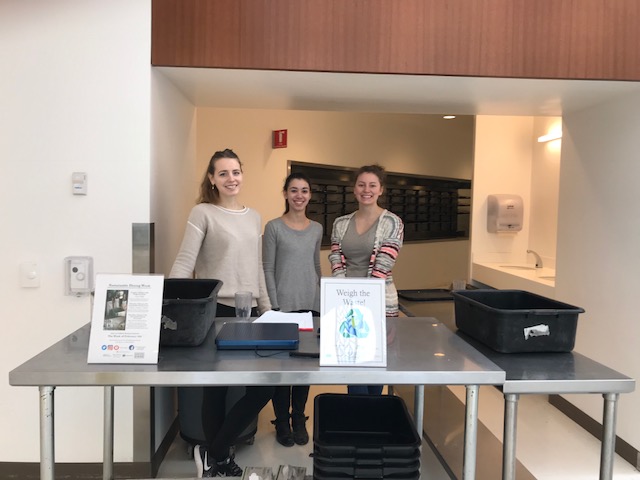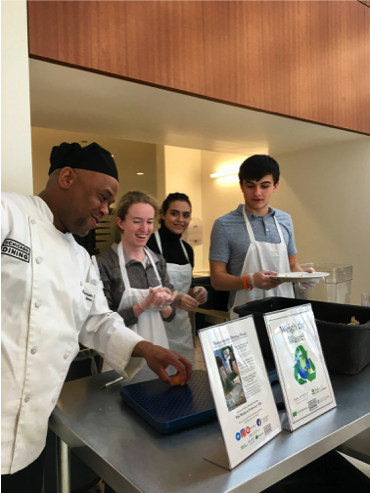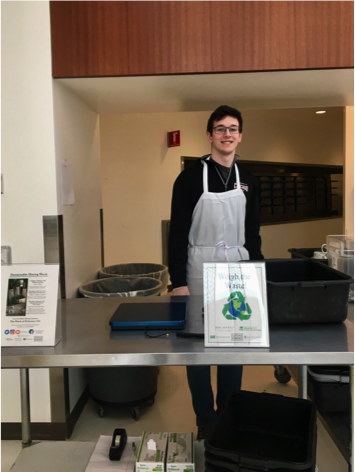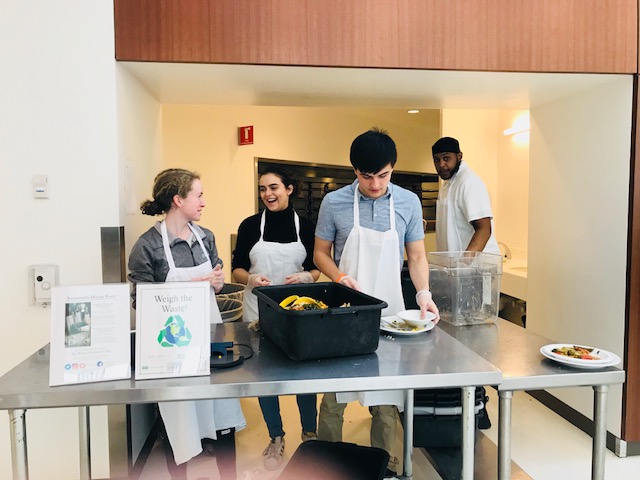By Ally Muszynski
Sustainable Dining Week (February 5-9th) started off great, with our Weigh the Waste event on Tuesday, February 13th, in which I joined volunteers from the Environment, Agriculture and Food Working Group, the Frizzell Family Speaker and Learning Series, and the Phoenix Sustainability Initiative to measure the food waste at Baker Dining Commons during the span of one lunch period. We received generally positive feedback from diners, as they were cooperative and ready to help scrape their food into the bins. Some diners also asked questions about the amount of waste we had accumulated up until that point, if the data collected would be accessible to students, and, the ever-present question, what exactly we were doing. Because it was lunch rush hour, there wasn’t a moment of rest; every time we scraped the food off of one plate, two more appeared.
We worked diligently to get as much plate waste as possible into the tub for measurement and ultimately ended up with 75.18 lbs of trash in the span of two and a half hours, consumed by 436 guests, averaging around .172 lbs or 2.75 oz of food waste per person. At last year’s Weigh the Waste event in Baker Dining Commons, we collected 101.5 lbs of food waste, but no data on the number of visitors is available. At Cathey Dining Commons in Campus South last year, however, there were 121.6 lbs of waste for 830 people, creating 2.4 oz per person.
Based on a per-person comparison of Baker this year to Cathey in 2016, the average weight of food waste per person has seemed to increase in ounces. This could be attributed to many factors: first, the fact that the comparison is between two different dining halls is salient, as there is another variable added into the picture. The comparison would have been more appropriate if last year’s Baker data from last year included the number of patrons. Unfortunately, however, this data was somehow not included. Additionally, the sample size was smaller by almost half of that of Cathey in the Fall of 2016, so this could cause a skew in data as there could be more outliers in the data in Baker in Winter 2018. Additionally, being a frequent consumer at Baker, I know anecdotally, the portions they give are larger than those at Cathey. Further, perhaps the student body reflected in the sample was not fond of a specific menu item that day and contributed more to the waste. We did not take specific note of which food items were being wasted the most, but this is something we could investigate in a future Weigh the Waste event. Finally, perhaps the population represented was unaware of how much food waste they actually generate, as Baker is most often visited by underclassmen, especially first years, who might be unaware of their consumption due to their limited time at the university.
Once this food is considered waste, it goes through biodigesters, which turn it into gray water and small amounts of food waste, effectively reducing the university’s contribution to landfills and the cost we spend on the disposal of waste foods. Through an entire year, in Baker, we contribute around 111,463.52 lbs of food to the biodigester, saving these thousands of pounds from simply entering a landfill, not to mention the 10.6 metric tons of carbon emissions saved from entering the atmosphere, and the university’s overall savings of around $4000 annually.
Campus food waste is a huge problem around the world, contributing hundreds of thousands of tons of CO2 emissions and pounds of waste to landfills worldwide. In the US alone, around 40% of food isn’t consumed, and the majority of this usually ends up in landfills. Such a large aggregate of people, like a university can create tons of waste rapidly, so knowing consumption patterns of students, and actively trying to reduce their consumption is a great step in reducing food waste. Other top universities are trying to meet similar goals, between composting hundreds of pounds of food waste at Dartmouth, Princeton, Yale, Stanford and Harvard, and launching similar campaigns to our Weigh the Waste event, we are very comparable, to schools aware of the issue of college dining waste.
Overall, the Weigh the Waste event was a great success, and despite the fact that it seems as if we are wasting more food, the fact that we could even gather the data will be paramount in our attempt to reduce food waste at the university. The first step toward conservation is awareness of the problem, and now that we have the figures, we can use them to design interventions to reduce our food waste. More personally, I found this event extremely interesting and rewarding. Learning where our waste goes, and how much we produce is invaluable, and the fact that we have a dining company like Bon Appetit so willing to be transparent with us about what happens to the food we do (and don’t) eat is a very fortunate thing to have.
Ally is a second year Environmental and Urban Studies Major hailing from Houston, Texas. Her interest in sustainability started at a young age, through her work in an aquarium.





